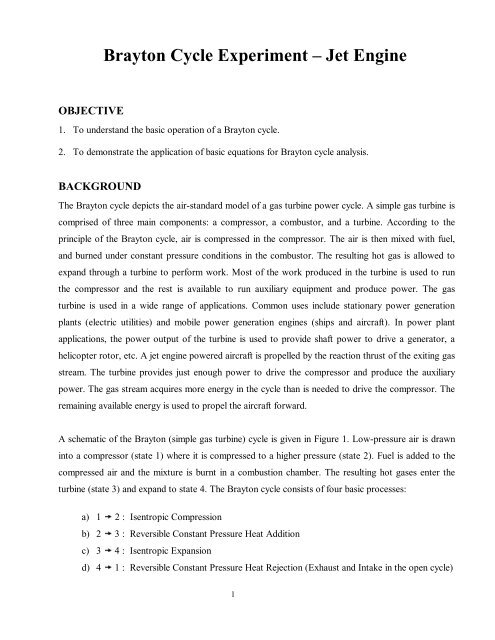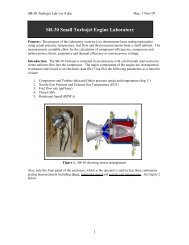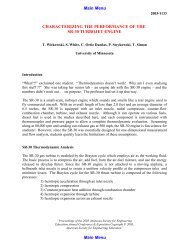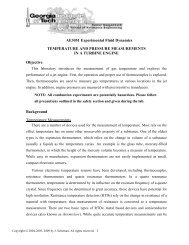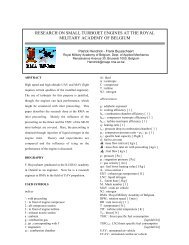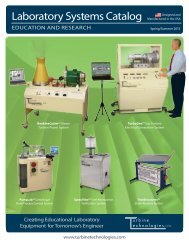Brayton Cycle Experiment – Jet Engine - Turbine Technologies
Brayton Cycle Experiment – Jet Engine - Turbine Technologies
Brayton Cycle Experiment – Jet Engine - Turbine Technologies
You also want an ePaper? Increase the reach of your titles
YUMPU automatically turns print PDFs into web optimized ePapers that Google loves.
OBJECTIVE<br />
<strong>Brayton</strong> <strong>Cycle</strong> <strong>Experiment</strong> – <strong>Jet</strong> <strong>Engine</strong><br />
1. To understand the basic operation of a <strong>Brayton</strong> cycle.<br />
2. To demonstrate the application of basic equations for <strong>Brayton</strong> cycle analysis.<br />
BACKGROUND<br />
The <strong>Brayton</strong> cycle depicts the air-standard model of a gas turbine power cycle. A simple gas turbine is<br />
comprised of three main components: a compressor, a combustor, and a turbine. According to the<br />
principle of the <strong>Brayton</strong> cycle, air is compressed in the compressor. The air is then mixed with fuel,<br />
and burned under constant pressure conditions in the combustor. The resulting hot gas is allowed to<br />
expand through a turbine to perform work. Most of the work produced in the turbine is used to run<br />
the compressor and the rest is available to run auxiliary equipment and produce power. The gas<br />
turbine is used in a wide range of applications. Common uses include stationary power generation<br />
plants (electric utilities) and mobile power generation engines (ships and aircraft). In power plant<br />
applications, the power output of the turbine is used to provide shaft power to drive a generator, a<br />
helicopter rotor, etc. A jet engine powered aircraft is propelled by the reaction thrust of the exiting gas<br />
stream. The turbine provides just enough power to drive the compressor and produce the auxiliary<br />
power. The gas stream acquires more energy in the cycle than is needed to drive the compressor. The<br />
remaining available energy is used to propel the aircraft forward.<br />
A schematic of the <strong>Brayton</strong> (simple gas turbine) cycle is given in Figure 1. Low-pressure air is drawn<br />
into a compressor (state 1) where it is compressed to a higher pressure (state 2). Fuel is added to the<br />
compressed air and the mixture is burnt in a combustion chamber. The resulting hot gases enter the<br />
turbine (state 3) and expand to state 4. The <strong>Brayton</strong> cycle consists of four basic processes:<br />
a) 1 � 2 : Isentropic Compression<br />
b) 2 � 3 : Reversible Constant Pressure Heat Addition<br />
c) 3 � 4 : Isentropic Expansion<br />
d) 4 � 1 : Reversible Constant Pressure Heat Rejection (Exhaust and Intake in the open cycle)<br />
1
CYCLE ANALYSIS<br />
k<br />
j<br />
Atmospheric<br />
Air<br />
W &<br />
Figure 1. Basic <strong>Brayton</strong> <strong>Cycle</strong><br />
in<br />
Qin &<br />
Combustor<br />
Thermodynamics and the First Law of Thermodynamics determine the overall energy transfer. To<br />
analyze the cycle, we need to evaluate all the states as completely as possible. Air standard models are<br />
very useful for this purpose and provide acceptable quantitative results for gas turbine cycles. In these<br />
models the following assumptions are made.<br />
1. The working fluid is air and treated as an ideal gas throughout the cycle;<br />
2. The combustion process is modeled as a constant-pressure heat addition;<br />
3. The exhaust is modeled as a constant-pressure heat rejection process.<br />
In cold air standard (CAS) models, the specific heat of air is assumed constant (perfect gas model) at<br />
the lowest temperature in the cycle. The effect of temperature on the specific heat can be included in<br />
the analysis at a modest increase in effort. However, closed form solutions would no longer be<br />
possible.<br />
2<br />
l<br />
Compressor <strong>Turbine</strong><br />
Hot<br />
Exhaust<br />
m<br />
W &<br />
output
To perform the thermodynamic analysis on the cycle, we consider a control volume containing each<br />
component of the cycle shown in Figure 1. This step is summarized below.<br />
Compressor<br />
Consider the following control volume for the compressor,<br />
Figure 2. Compressor Control Volume Model<br />
Note that ideally there is no heat transfer from the control volume (C.V.) to the surroundings. Under<br />
steady-state conditions, and neglecting the kinetic and potential energy effects, the first law for this<br />
control volume is then written as<br />
H�<br />
− W = H<br />
(1)<br />
in<br />
�<br />
in<br />
�<br />
out<br />
Considering that we have one flow into the control volume and one flow out of the control volume,<br />
we may write a more specific form of the first law as<br />
m� hin<br />
− m�<br />
wC<br />
= m�<br />
hout<br />
(2)<br />
Or, rearranging by grouping the terms associated with each stream,<br />
− w<br />
C = hout<br />
- hin<br />
This is the general form of the First Law for a compressor. However, if the fluid stream is assumed<br />
to ideal gases we may represent the enthalpies in terms of temperature (a much more measurable<br />
quantity) by using the appropriate equation of state ( dh = c pdT ), which will introduce the specific<br />
Assuming constant specific heats, enthalpy differences are readily expressed as temperature<br />
differences as<br />
− w<br />
C<br />
= c<br />
p.C<br />
( T - T )<br />
C, out<br />
C.V.<br />
C, in<br />
Compressor<br />
3<br />
€<br />
ó<br />
(3)<br />
(4)
To be more accurate, the specific heat of each fluid should be evaluated at the linear average between<br />
⎛ Tin + Tout<br />
⎞<br />
its inlet and outlet temperature, ⎜ ⎟ .<br />
⎝ 2 ⎠<br />
The irreversibilities present in the real process can be modeled by introducing the compressor<br />
efficiency,<br />
η<br />
COMP<br />
w<br />
=<br />
w<br />
C, s<br />
C, a<br />
=<br />
h<br />
h<br />
out, s<br />
out, a<br />
- h<br />
- h<br />
in<br />
in<br />
where the subscript s refers to the ideal (isentropic) process and the subscript a refers to the actual<br />
process. For a perfect gas the above equation is reduced to<br />
η<br />
COMP<br />
Combustor<br />
For the combustor,<br />
=<br />
T<br />
T<br />
out, s<br />
out, a<br />
- T<br />
- T<br />
in<br />
in<br />
Figure 3. Combustor Control Volume Model<br />
Note that ideally there is work transfer from the control volume (C.V.) to the surroundings. Under<br />
steady-state conditions, and neglecting the kinetic and potential energy effects, the first law for this<br />
control volume is then written as<br />
H�<br />
+ Q = H<br />
(7)<br />
in<br />
�<br />
in<br />
�<br />
out<br />
C.V.<br />
Combustor<br />
ó<br />
Considering that we have one flow into the control volume and one flow out of the control volume,<br />
we may write a more specific form of the first law as<br />
m� hin<br />
+ m�<br />
qC<br />
= m�<br />
hout<br />
(8)<br />
4<br />
ì<br />
(5)<br />
(6)
Or, rearranging by grouping the terms associated with each stream,<br />
q<br />
B = hout<br />
- hin<br />
Assuming ideal gases with constant specific heats, enthalpy differences are readily expressed as<br />
temperature differences as<br />
q<br />
B<br />
= c<br />
p.B<br />
( T - T )<br />
B, out<br />
B, in<br />
Again, to be more accurate, the specific heat of each fluid should be evaluated at the linear average<br />
between its inlet and outlet temperature.<br />
<strong>Turbine</strong><br />
Consider the following control volume for the turbine,<br />
Figure 4. <strong>Turbine</strong> Control Volume Model<br />
Note that ideally there is no heat transfer from the control volume (C.V.) to the surroundings. Under<br />
steady-state conditions, and neglecting the kinetic and potential energy effects, the first law for this<br />
control volume is then written as<br />
in<br />
�<br />
out<br />
�<br />
out<br />
5<br />
(9)<br />
(10)<br />
H�<br />
− W = H<br />
(11)<br />
Considering that we have one flow into the control volume and one flow out of the control volume,<br />
we may write a more specific form of the first law as<br />
m� hin<br />
− m�<br />
wT<br />
= m�<br />
hout<br />
(12)<br />
Or, rearranging by grouping the terms associated with each stream,<br />
− w<br />
T = hout<br />
- hin<br />
C.V.<br />
<strong>Turbine</strong><br />
ì<br />
ö<br />
(13)
Assuming ideal gases with constant specific heats, enthalpy differences are readily expressed as<br />
temperature differences as<br />
− w<br />
T<br />
= c<br />
p.T<br />
( T - T )<br />
T, out<br />
T, in<br />
As before, the specific heat of each fluid should be evaluated at the linear average between its inlet<br />
and outlet temperature for more accurate results.<br />
The irreversibilities present in the real process can be modeled by introducing the turbine isentropic<br />
efficiency,<br />
wC,<br />
a hout,<br />
a - hin<br />
ηTURB<br />
= =<br />
wC,<br />
s hout,<br />
s - hin<br />
(15)<br />
where the subscript s refers to the ideal (isentropic) process and the subscript a refers to the actual<br />
process. For a perfect gas the above equation is reduced to<br />
η<br />
TURB<br />
=<br />
T<br />
T<br />
out, a<br />
out, s<br />
- T<br />
- T<br />
in<br />
in<br />
EXPERIMENTAL SETUP<br />
The laboratory setup is a self-contained, turnkey and portable propulsion laboratory manufactured by<br />
<strong>Turbine</strong> <strong>Technologies</strong> Ltd. called TTL Mini-Lab. The Mini-Lab consists of a real jet engine.<br />
Therefore, the same safety concerns of running a jet engine are present. Care must be taken to follow<br />
all the safety procedures precisely as outlined in the laboratory and stated by your lab instructors. The<br />
following description of the setup is provided by the manufacturer.<br />
“A <strong>Turbine</strong> <strong>Technologies</strong> Model SR-30 turbojet engine is the systems primary<br />
component. Operational sound and smell are hard to distinguish from any idling,<br />
small business jet. The engine’s axial turbine wheel and vane guide ring are vacuum<br />
investment castings. They are produced from modern, high cobalt and nickel<br />
content super alloys (MAR-M-247 and Inconnel 718). The combustion chamber<br />
consists of an annular, counterflow system, including internal film cooling strips.<br />
Fuel and oil tanks, filters, oil cooler, all necessary plumbing and wiring is located in<br />
the lower part of the Mini-Lab structure. A throttle lever is located on the right side<br />
of the operator and above the slanted instrument panel. The throttle enables the<br />
6<br />
(14)<br />
(16)
operator to perform smooth power changes between idle and maximum N1. Digital<br />
engine RPM and E.G.T. gauges, mechanical E.P.R., Oil, Fuel, Air start pressure<br />
gauges are also part of the standard panel. Annunciator lights indicate low oil<br />
pressure, ignitor on, and air-start status. A key operated master switch controls the<br />
main electric power bus. Other panel-mounted switches control igniter, air start, and<br />
activate fuel flow. The SR-30 engine’s fuel system is very similar to large-scale<br />
engines—fuel atomization via 6 return flow high-pressure nozzles that allow<br />
operation with a wide variety of kerosene based liquid fuels (e.g. diesel, <strong>Jet</strong> A, JP-4<br />
through 8).”<br />
Figure 5. <strong>Turbine</strong> <strong>Technologies</strong>’s “MiniLab” <strong>Engine</strong><br />
<strong>Engine</strong> Components.<br />
The engine consists of a single stage radial compressor, a counterflow annular combustor and a single<br />
stage axial turbine which directs the combustion products into a converging nozzle for further<br />
expansion. Details of the engine may be viewed from the ‘cutaway’ provided in Fig. 6.<br />
7
Instrumentation.<br />
The sensors are routed to a central access panel and interfaced with data acquisition hardware and<br />
software from National Instruments. The manufacturer provides the following description of the<br />
sensors and their location.<br />
“The integrated sensor system (Mini-Lab) option includes the following probes:<br />
Compressor inlet static pressure (P ), Compressor stage exit stagnation pressure<br />
1<br />
(P ), Combustion chamber pressure (P ), <strong>Turbine</strong> exit stagnation pressure (P ),<br />
02 3 04<br />
Thrust nozzle exit stagnation pressure (P ), Compressor inlet static temperature<br />
05<br />
(T ), Compressor stage exit stagnation temperature (T ), <strong>Turbine</strong> stage inlet<br />
1 02<br />
stagnation temperature (T ), <strong>Turbine</strong> stage exit stagnation temperature (T ), and<br />
03 04<br />
thrust nozzle exit stagnation temperature (T ). Additionally, the system includes a<br />
05<br />
fuel flow sensor and a digital thrust readout measuring real time thrust force based<br />
upon a strain gage thrust yoke system.”<br />
Figure 6. <strong>Turbine</strong> <strong>Technologies</strong>’s SR-30 <strong>Engine</strong><br />
Cut Away View of SR-30 <strong>Engine</strong><br />
8
EXPERIMENTAL PROCEDURE<br />
SAFETY NOTES:<br />
1. Make sure you are wearing ear protection. If you are not sure how the<br />
earplugs are properly used, ask you lab instructor for a demonstration.<br />
Never stay in the laboratory without ear protection while the engine is in<br />
operation.<br />
2. The SR-30 engine operates at high rotational speeds. Although there is a<br />
protective pane that separates the engine from the operator, make certain<br />
that you do not lean too close to this pane.<br />
3. Make sure the low-oil-pressure light goes off immediately after an<br />
engine start. If it stays on or comes on at any time during the engine<br />
operation cut off the fuel flow immediately.<br />
4. There is a vibration sensor whose indicator is to the far right of the<br />
operator’s panel. If this indicator shows any activity (increase in voltage)<br />
shut-off the engine immediately.<br />
5. If at any time you suspect something is wrong shut off the fuel<br />
immediately and notify the lab instructor.<br />
6. If the engine is hung (starts but does not speed up to idle speed of about<br />
40,000 rpm) turn the air-start back on for a short while until the engine<br />
speeds up to about 30,000 rpm. Then turn off the air-start switch.<br />
� MAKE SURE NEITHER YOU NOR ANY OF YOUR BELONGINGS<br />
ARE PLACED IN FRONT OF THE INTAKE TO OR EXHAUST FROM<br />
THE ENGINE WHEN THE ENGINE IS RUNNING.<br />
9
1. Ask your TA to load the data acquisition program and run the pre-programmed LabView VI for<br />
this lab. The screen should display readings from all sensors. Review the readouts to make sure<br />
they are working properly.<br />
2. Make sure that the air pressure in the compressed-air-start line is at least 100 psia (not exceeding<br />
120 psia). Ask your lab instructor to check the oil level.<br />
3. Make the appropriate length measurements and record the required dimensions so you can<br />
calculate the inlet area (where the sensors are).<br />
4. Ask the help of your lab instructor turn on the system and start the engine. After the engine is<br />
successfully started, you must first allow the engine to achieve the idle speed before making any<br />
measurements. Make sure the throttle is at its lowest point. The idle position is nearly vertical,<br />
and is close to the operator (away from the engine).<br />
5. Slowly open the throttle. Start taking data at about 65,000 rpm. Make sure that you allow the<br />
engine time to reach steady state by monitoring the digital engine rpm indicator on panel. The<br />
reading fluctuates somewhat so use your judgement.<br />
6. Take data at three different engine speeds. You will use the data to study how cycle and<br />
component efficiencies change with speed.<br />
7. After you are done taking data, turn off the fuel flow switch first.<br />
8. The data will be stored in Excel spreadsheet format<br />
DATA ANALYSIS<br />
Using the collected data determine the turbine isentropic efficiency, compressor isentropic efficiency,<br />
the thermal efficiency of the cycle and the corresponding Carnot efficiency.<br />
REPORT<br />
In your report determine the performance of the ideal cycle operating with the same maximum cycle<br />
temperature, mass flow rate, and compression ratio. Compare the performance of the ideal cycle<br />
with measured performance. Discuss the differences.<br />
SUGGESTIONS FOR DISCUSSION<br />
1. How does the cycle efficiency compare with the ideal <strong>Brayton</strong> cycle? with the Carnot cycle?<br />
2. How does the component efficiency affect the cycle efficiency?<br />
3. How do the component efficiencies you calculated based on your test data compare with those of<br />
typical of those gas turbine engines?<br />
10


